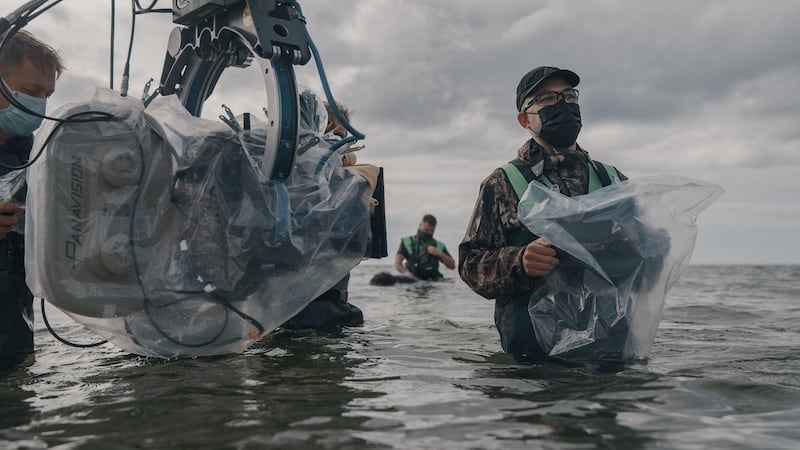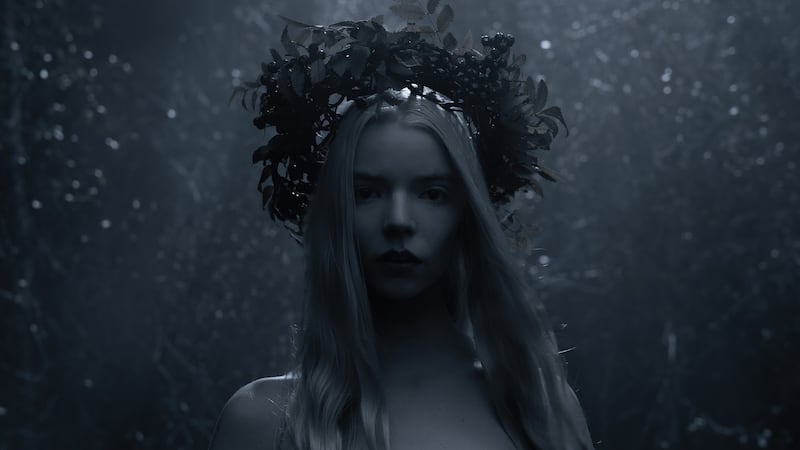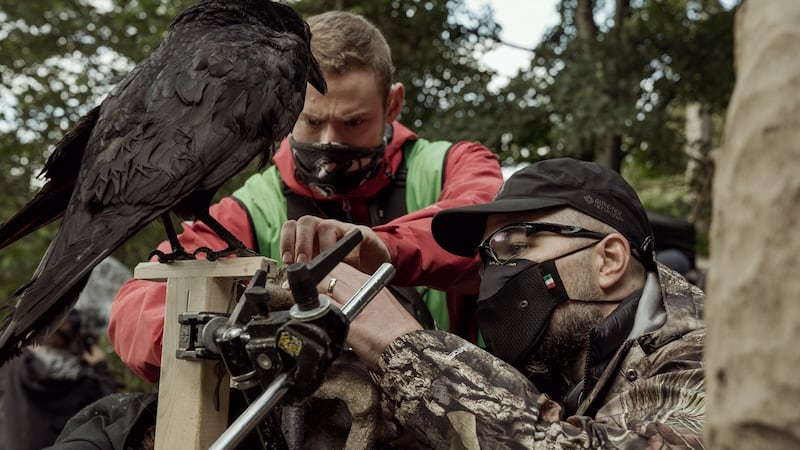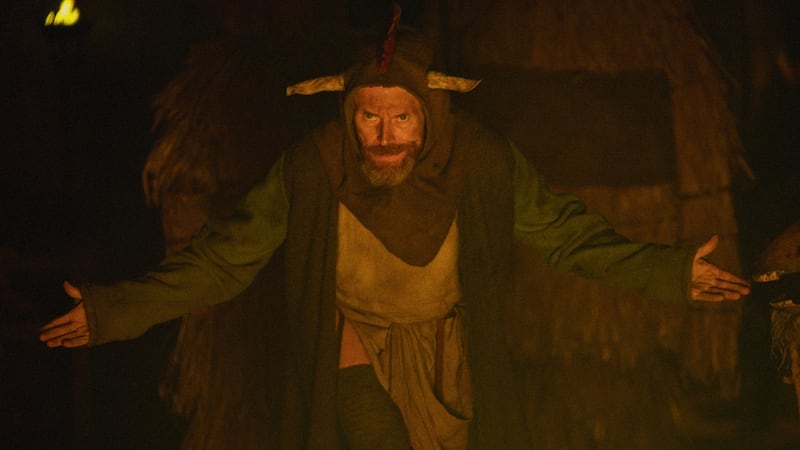A lot has gone on since I last met Robert Eggers. At a Q&A following a screening of his already legendary The Lighthouse at (where else?) The Light House Cinema, he talked enthusiastically about his recent recreation of 10th century Norse communities in meteorologically appropriate Ulster. This was the Christmas of 2019. The Northman, an epic Viking drama, was all set to crank into production.
So did they get a camera running before Covid hit?
“No. We were a week away. We were doing hair and make-up and costume tests,” he says. “Covid did make shooting the film much more difficult, but the hiatus was, frankly, needed. We had more time to plan and prepare. The scope of this film was so much larger than anything me and my collaborators had undertaken – and this gave us time to dot our ‘i’s and cross our ‘t’s. And it gave some of the actors more time to grow out their beards. Some of the massive sets got to gestate and integrate into the landscape.”

It is traditional for filmmakers shooting in Ireland to reassure us that the citizens are supernaturally friendly and the nightlife is beyond compare. But these were different times. When, at night, they finished filming around Belfast or at Torr Head in Antrim or out on the Inishowen Peninsula in Donegal, the crew were required to don masks and make for shelter.
Was there any socialising?
“No, just the first few months, which was very enjoyable,” he says. “But after that we felt this massive responsibility. And no one wanted to get Covid. So no one left their apartments or their hotel rooms. We just went out to get coffee at Established [in Belfast] and that was about it.”
Eggers and his team really pulled it off. Based on the source material for Hamlet, The Northman stars every muscular ounce of Alexander Skarsgård as a Norse prince who, years after his uncle kills the boy's father and marries his mother, returns to exact the bloodiest, most viscera-drenched class of revenge. Nicole Kidman is mum. Willem Dafoe plays a court fool who, during the later sections, has his manky skull co-opted into a pastiche of poor Yorick's famous postmortem cameo.

Supporters of Eggers’s The Witch, an unsettling supernatural yarn from the Puritan era, and his The Lighthouse, a Melvillian tale of madness, will recognise the director’s signature peculiarities. The supernatural is woven in with the quotidian. There is a reverence for the social grammar of earlier civilisations. But The Northman plays out on a vastly expanded canvas. The Witch cost around $4 million. The Lighthouse cost $11 million. His new film cost a staggering $90 million. The crew was much larger. The shoot was longer. The expectations from investors were now through the ceiling.
Pressure
I imagine he felt a tiny bit of pressure.
“It was incredibly intimidating,” he says. “And if I had ever truly faced the pressure and responsibility in the mirror I would have died. But obviously I have enough hubris to be a film director. I could write volumes and volumes about what I learned. I finally feel like I know how to make a movie for the first time. Aside from the fact that I am getting to make the film I wanted to make, I am grateful for the experience. It was like I got a PhD in filmmaking.”
In comparison, his previous two films feel like the product of cottage industries. Raised in New Hampshire, the son of an academic, Eggers was helping with amateur theatre production while still a teenager. He shot experimental films throughout his schooldays and, after moving to New York, devoted himself to an array of projects in various media. Working with no huge studio lurking over his shoulder, he was able to stay true to his vision when making The Witch. Featuring Robert Pattinson and Willem Dafoe in narrow-ratio monochrome, The Lighthouse could hardly have seemed more eccentric if it were performed in semaphore.
A recent profile in the New Yorker suggests, however, that there were struggles on The Northman. The magazine reports that early test audiences rated the film in the “mid-sixties” (out of 100) and that “the studio wanted more like seventy-five”. One of the test viewers suggested you needed “a master’s degree in Viking history” to understand anything. This doesn’t sound like fun.

“I needed the pressure from the studio to get the film into the shape that it’s in,” he says magnanimously. “I couldn’t have done it alone. But was it enjoyable? No. It was awful. But we would get a bad note session and Sjón, my co-writer, would say: ‘If we can’t interpret the studio notes in a way that we are proud of then we’re simply not working hard enough.’ And that was the only attitude to have. But my god, I have never worked harder.”
The Northman looks to have satisfied the competing factions. The film is somewhat more mainstream than his previous two works, but it is still significantly odder than any other $90-million entertainment you will see this year. The violence is relentless. The winding of Norse magic in with medieval war crimes is deliberately unsettling. This feels unmistakably an Eggers joint.
'This is the movie that I love and am proud of. But I'm used to making smaller movies that don't need to be entertaining'
“What you see is the director’s cut,” he says. “There is not going to be something on the Blu-ray that is preferable. This is the movie that I love and am proud of. But I’m used to making smaller movies that don’t need to be entertaining.”
But they are. The Witch and The Lighthouse are, in their grim ways, both darn good fun.
“Sure, sure. But that was not my number-one goal.”
Hamlet
Those approaching The Northman with no prior knowledge will be surprised to see one of the most celebrated stories in English literature unfold. Skarsgård is a version of Hamlet. Kidman, as Gudrún, gives an excellent trial run for the Gertrude she deserves to sometime deliver. Few formal versions of Shakespeare’s play have quite so much disembodied lower intestine on the throne-room floor, but the path from Saxo Grammaticus’s Amleth, medieval Scandinavian source, through to the better-known work is unmistakable.
'I think the film that gets the most quotes, just because I watched it so much as a kid... is John Milius's Conan the Barbarian'
“I didn’t think about Hamlet at all when we were actually making the film,” he says. “My father’s a Shakespeare professor. I have directed Hamlet. But somehow it didn’t stick with me that the inspiration for Shakespeare’s Hamlet was Nordic. Ha, ha! But yeah, when I found Amleth I was very excited, because I found a story that everyone knows. So I can indulge in Viking culture and mythology, knowing people know the story. There are things here that are also in Hamlet, but that are not in Saxo Grammaticus. There is a bedroom scene with Gudrún and also he talks to the severed head of the Fool. So there’s that.”

There is also a fair bit of Ben Hur. Amleth serves time behind an oar and is captured as a slave. He succeeds at his captors’ violent celebratory games. Was that just coincidence?
“I didn’t revisit Ben Hur,” he says. “I did revisit Spartacus. But I think the film that gets the most quotes, just because I watched it so much as a kid – some of them are intentional, and some of them are not intentional – is John Milius’s Conan the Barbarian.”
Chatting about the rigorous research he undertook before embarking on the project, Eggers notes that the shackles on the slaves were modelled on those from an archaeological find in Dublin. The film aims to offer the most authentic depiction of Viking life yet seen in a motion picture. Once again, Eggers is remaining on brand. The actors in The Witch wore shoes with wooden soles. Jarin Blaschke, who received an Oscar nomination for The Lighthouse, shot with lenses that suggested 19th century photography. Why do these details matter? How many in the audience will notice?
“I have various answers. And I don’t really know the reason why it’s so important to me,” he says cheerily. “But I probably would have been a historian if I hadn’t wanted to tell stories. It’s just something that I personally enjoy. Does it matter? In Guillermo del Toro’s Crimson Peak, the Victorian house is work of pure imagination. And it’s beautiful. One thing is that I am trying to articulate the Viking mind, and the more the physical world is fully realised, the accumulation of details, the more you can invest in an undead, mound-dwelling warrior being real. Maybe.”
Colossal budget
The combination of Covid and that colossal budget did not make for an easy shoot. And life has not been an untroubled breeze since The Northman locked. He moved on to a long-cherished remake of FW Murnau's Nosferatu – retooled in 1979 by Werner Herzog – featuring unavoidable pop multitasker Harry Styles, but that New Yorker piece tells us the production was delayed when Styles withdrew due to "scheduling concerns". Is this accurate?
“They’re the New Yorker. They fact-check everything,” he says with a shrug. “It would be a shame if Nosferatu never happened. Then again, it’s fallen apart twice and maybe Murnau’s ghost is saying: ‘I let Herzog get away with it because of his place in German cinematic history. Maybe just do something else.’ Ha, ha!”
Eggers is, as we have ascertained, not short on determination. He will plug away until he gets what he wants on screen. That task is not going to get any easier. Cinemas are still reeling from the aftermath of the pandemic. Eccentric projects on the scale of The Northman are going to be increasingly hard to finance in the coming years. Streaming services offer an alternative. But Eggers’s current film deserves to be seen in the same sort of public venues that screened Spartacus, Ben Hur and Conan the Barbarian.
“I’m a filmmaker who’s desperately invested in cinema staying alive, but I know it’s hard,” he says before putting on a comically pompous accent. “But I would ask your readers to please see The Northman in cinemas. Ha, ha!”
Listen to what the man says.
The Northman is on general release.













